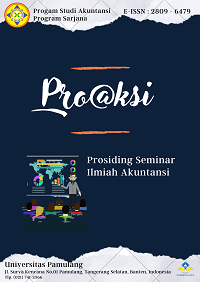Pengaruh Arus Kas Operasi dan Besarnya Hutang Terhadap Financial Distresss
Keywords:
Amount of Debt, Financial Distresss, Operating Cash FlowAbstract
This study aims to determine the effect of operating cash flow and the amount of debt on Financial Distress. The independent variables used in this study are operating cash flow and the amount of debt, while the dependent variable in this study is Financial Distress. This type of research is quantitative. The population in this study are financial sector service companies listed on the Indonesia Stock Exchange during the 2016-2020 period. The sample selection method used the Purposive Sampling method, based on this method obtained as many as 15 companies multiplied by a period of 5 years so that the sample in this study was 75. The data used in this study were secondary data in the form of annual financial reports (Annual Reports) and financial statements of the sub-company financial sector listed on the Indonesia Stock Exchange 2016-2020. The data analysis technique uses multiple linear regression analysis with E-views version 9. The results of this study simultaneously show that operating cash flow and the amount of debt have a positive effect on Financial Distress in financial sector service companies. While the research that was carried out partially showed that operating cash flow had no effect on Financial Distress and partially showed that the amount of debt had a negative effect on Financial Distress in financial subsector companies listed on the Indonesia Stock Exchange in 2016-2020.
References
Amarilla Ulfi, Kania Nurcholisah dan Diamonalisa Sofianty. (2017). “Pengaruh Arus Kas Operasi dan Ukuran Perusahaan Terhadap Financial Distresss (Studi Empiris Pada Perusahaan Pertambangan Batubara Yang Terdaftar di Bursa Efek Indonesia Periode Tahun 2014-2016).â€
Brigham & Houston. 2014. Dasar-Dasar Manajemen Keuangan. Jakarta: Salemba Empat.
Hendrianto. 2012. “Tingkat Kesulitan Keuangan Perusahaan dan Konservatisme Akuntansi di Indonesiaâ€. Jurnal Ilmiah Mahasiswa Akuntansi. Vol. 1, No. 3. Hlm. 62-66.
I Made Sudana, (2017). “Manajemen Keuangan Teori dan Praktikâ€. Malang: Airlangga University Press.
LCA. Robin Jonathan dan Theresia Militina. (2018). “Pengaruh Utang Terhadap Nilai Perusahaan Dan Financial Distresss Perusahaan Batubara Yang Go-Public Di Indonesia.†ISSN CETAK 1412-6877. ISSN ONLINE 2528-0538.
Mappadang, Agoestina., Syauqi Ilmi., Wuri Septi Handayani., Amir Indrabudiman. (2019). “Faktor-Faktor Yang Mempengaruhi Financial Distresss Pada Perusahaan Transportasi.†Vol.4, No. S1 (2019) Tantangan Bisnis di Era Digital: 583 - 696. P-ISSN 2527–7502 E-ISSN 2581-2165.
Marpaung dan Pratama (2017) tentang “Analisis rasio keuangan untuk memprediksi kondisi Financial Distresss pada perusahaan manufaktur yang terdaftar di Bursa Efek Indonesia periode 2014-2015â€.
Prasetya, E. R., & Oktavianna, R. (2021). Financial Distress Dipengaruhi oleh Sales Growth dan Intellectual Capital. JABI (Jurnal Akuntansi Berkelanjutan Indonesia), 4(2), 170-182.
Radiansyah, Bagus. (2013). Pengaruh Efisiensi Operasi, Arus Kas Operasi, Dan Pertumbuhan Perusahaan Dalam Memprediksi Financial Distresss. E-Jurnal Akuntansi Universitas Negeri Padang. Vol. 1 No.3.
Sugiyono. (2018). Metode Penelitian Kuantitatif. Bandung: Alfabeta.
Wahyuningtyas, Fitria. (2010). Penggunaan Laba dan Arus Kas untuk Memprediksi Kondisi Financial Distresss : Studi Kasus pada Perusahaan bukan Bank Yang Terdaftar Di BEI Periode Tahun 2005-2008. Skripsi. Universitas Diponegoro.



